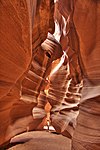File:Piles of Salt Salar de Uyuni Bolivia Luca Galuzzi 2006 a.jpg

Original file (2,000 × 1,320 pixels, file size: 892 KB, MIME type: image/jpeg)
|

|
This image was selected as picture of the day on Wikimedia Commons for 19 June 2007. It was captioned as follows: Other languages:
Afrikaans: Southopies bevorder verdamping in die Salar de Uyuni, Bolivië Español: Montículos de sal en el Salar de Uyuni, Bolivia. (Foto: Luca Galuzzi - http://www.galuzzi.it) Français : Récolte du sel dans le Salar de Uyuni, en Bolivie. (Photo : Luca Galuzzi - http://www.galuzzi.it) Nederlands: Zoutheuvels voor de zoutwinning op de Salar de Uyuni in Bolivia. (Foto: Luca Galuzzi - http://www.galuzzi.it) Polski: Kopce solne w solnisku Salar de Uyuni, w Boliwii (fot. Luca Galuzzi - http://www.galuzzi.it) Беларуская: Саляныя капцы на саляным возеры Салар дэ Ююні (Балівія) |
| DescriptionPiles of Salt Salar de Uyuni Bolivia Luca Galuzzi 2006 a.jpg |
العربية: تراكُمات ملحيَّة في سالار دو أويوني، في بوليڤيا. تُعتبرُ سالار دو أويوني أكبر (12 000 كلم²) وأعلى (3 700 م) بُحيرة ملحيَّة على سطح الأرض، فهي تفوقُ بُحيرة بونيڤيل الملحيَّة حجمًا بِحوالي. 25 مرَّة. وهي كُل ما تبقَّى من بُحيرةٍ قبتاريخيَّة تُحيطُ بها الجبال دون أن يكون لها أيَّة مصارف أو مجارٍ. يُجمعُ الملح من هذا المكان بالطُرق التقليديَّة: يُكشطُ الملح ويُجمعُ في أكوامٍ صغيرة كي يتبخَّر منهُ الماء وكي يسهل تجميعه ونقله، ثُمَّ يتم تجفيفه فوق النار، وأخيرًا يُخصَّبُ بِاليُود.
Deutsch: Salzhügel im Salar de Uyuni in Bolivien. Der Salar de Uyuni ist der größte (12.000 km²) und höchste (3700m) Salzsee der Welt, ungefähr 25 mal so groß wie die Bonneville Salt Flats. Er ist entstanden aus einem durch Berge eingeschlossenen prähistorischen See ohne Abfluß. Salz wird in der traditionellen Methode gewonnen: Das Salz wird zu kleinen Hügeln zusammengerecht zur Wasserevaporation und zum leichteren Transport, danach wird es über Feuer getrocknet und mit Jod angereichert.
English: Salt mounds in Salar de Uyuni, Bolivia. The Salar de Uyuni is the world's largest (12 000 km²) and highest (3 700 m) salt flat, ca. 25 times as large as the Bonneville Salt Flats. It's the remnant of a prehistoric lake surrounded by mountains without drainage outlets. Salt is harvested in the traditional method: the salt is scraped into small mounds for water evaporation and easier transportation, dried over fire, and finally enriched with iodine.
Español: Pilas de sal en el Salar de Uyuni (Bolivia), la mayor salina del mundo. Es el remanente de un lago prehistórico rodeado por montañas sin salidas de drenaje. La sal se cosecha con el método tradicional: se amontona enpequeñas pilas para que se evapore el agua y para transportarla fácilmente, secada al fuego, y enriquecida finalmente con yodo.
Français : Récolte du sel dans le Salar de Uyuni, en Bolivie. Le Salar de Uyuni (3 700 m) couvre une surface de 12 000 km² soit la taille de l'Île-de-France, ce qui en fait le désert de sel le plus grand et le plus élevé du monde. Ce désert résulte de l'assèchement d'un lac préhistorique entouré de montagnes et privé d'émissaire. La récolte du sel se fait de façon traditionelle : le sel récolté est façonné en monticules, ce qui favorise l'évaporation de l'eau qu'il contient, et facilite son transport. Le sel est ensuite séché au feu, et enfin enrichi en iode.
Italiano: Raccolta del sale nel Salar de Uyuni, Bolivia. Il Salar de Uyuni è il più grande (12.000 km²) e più in alto (3.700 m) deserto di sale del mondo, con una superficie più estesa dell'Abruzzo. Deriva dal prosciugamento di un lago salato preistorico circondato dalle montagne e senza drenaggio. Il sale viene raccolto in modo tradizionale, accumulato in piccole montagnette in modo che l'acqua evapori poi viene asciugato sul fuoco e arricchito con iodio.
日本語: ボリビア、ウユニ塩湖の製塩用の塩の山。ここでは湖の塩を削り取り小山を作って乾燥させるという伝統的手法で塩が生産されている。ウユニ塩湖は世界で最も大きく、最も標高の高い塩類平原で (12 000 km²、3 700 m)、ボンネビル・ソルトフラッツの約25倍の大きさにあたる。
Türkçe: Bolivya'da bulunan ve Dünya'nın en büyük tuz göllerinden biri olan Salar de Uyuni'deki tuz tepecikleri. |
||
| Date | |||
| Source | Photo taken by (Luca Galuzzi) * http://www.galuzzi.it | ||
| Author | Luca Galuzzi (Lucag), edit by Trialsanderrors | ||
| Permission (Reusing this file) |
I, the copyright holder of this work, hereby publish it under the following license: This file is licensed under the Creative Commons Attribution-Share Alike 2.5 Generic license.
|
||
| Other versions |
 |
| Camera location | 20° 19′ 00″ S, 66° 59′ 00″ W | View this and other nearby images on: OpenStreetMap |
|---|
This is a retouched picture, which means that it has been digitally altered from its original version. Modifications: Made for Wikipedia:
|
Captions
14 April 2006
20°19'0.001"S, 66°58'59.999"W
image/jpeg
File history
Click on a date/time to view the file as it appeared at that time.
| Date/Time | Thumbnail | Dimensions | User | Comment | |
|---|---|---|---|---|---|
| current | 07:30, 22 March 2007 |  | 2,000 × 1,320 (892 KB) | wikimediacommons>Trialsanderrors | {{Information |Description={{en|Piles of Salt on the Salar de Uyuni, Bolivia.}} {{it|Raccolta del sale nel Salar de Uyuni, Bolivia.}} |Source=Photo taken by (Luca Galuzzi) * http://www.galuzzi.it |Date=2006-04-14 |Aut |
File usage
The following 9 pages use this file:
Metadata
This file contains additional information, probably added from the digital camera or scanner used to create or digitize it.
If the file has been modified from its original state, some details may not fully reflect the modified file.
| Author | Luca Galuzzi - www.galuzzi.it |
|---|---|
| Date and time of data generation | 16 April 2006 |
| Copyright holder | licensed under the Creative Commons Attribution ShareAlike 2.5 License |
| IIM version | 2 |
| Credit/Provider | Luca Galuzzi |
| Source | www.galuzzi.it |
| Urgency | Normal (5) |
| Contact information | www.galuzzi.it |
| JPEG file comment | File written by Adobe Photoshop¨ 5.0 |


